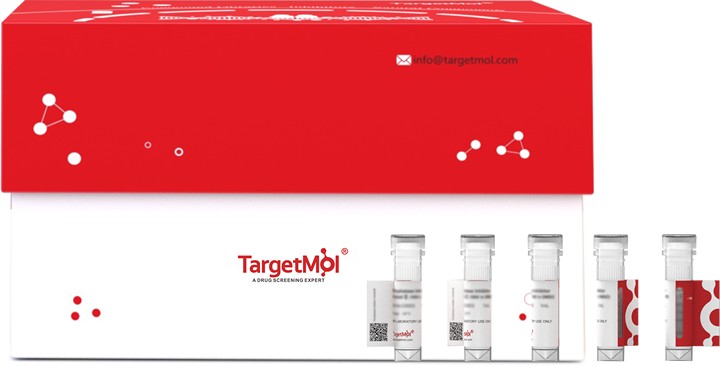- 全部删除
 您的购物车当前为空
您的购物车当前为空
OTUB2 Protein, Human, Recombinant (His)
Otubain 2 (OTUB2) is a member of DUBs that belong to the ovarian tumour (OTU) superfamily of proteins which consists of a five-stranded β-sheet sandwiched in between a small helical amino-terminal region consisting of α1 and α2, and a large helical region comprised of α3-α10. Like other DUBs, otubain 2 (OTUB2) cleaves proteins precisely at the ubiquitin-protein bond so that ubiquitylation process can be reversed and regulated. Otubain 2 (OTUB2)'s active-site cleft is sterically occluded by a novel loop conformation resulting in an oxyanion hole, which consists uniquely of backbone amides. Furthermore, the residues that orient and stabilize the active-site histidine of otubain 2 (OTUB2) are different from other cysteine proteases. This reorganization of the active-site topology provides a possible explanation for the low turnover and substrate specificity of the otubains.

OTUB2 Protein, Human, Recombinant (His)
| 规格 | 价格 | 库存 | 数量 |
|---|---|---|---|
| 100 μg | ¥ 1,890 | 5日内发货 |
产品信息
| 生物活性 | Activity testing is in progress. It is theoretically active, but we cannot guarantee it. If you require protein activity, we recommend choosing the eukaryotic expression version first. |
| 产品描述 | Otubain 2 (OTUB2) is a member of DUBs that belong to the ovarian tumour (OTU) superfamily of proteins which consists of a five-stranded β-sheet sandwiched in between a small helical amino-terminal region consisting of α1 and α2, and a large helical region comprised of α3-α10. Like other DUBs, otubain 2 (OTUB2) cleaves proteins precisely at the ubiquitin-protein bond so that ubiquitylation process can be reversed and regulated. Otubain 2 (OTUB2)'s active-site cleft is sterically occluded by a novel loop conformation resulting in an oxyanion hole, which consists uniquely of backbone amides. Furthermore, the residues that orient and stabilize the active-site histidine of otubain 2 (OTUB2) are different from other cysteine proteases. This reorganization of the active-site topology provides a possible explanation for the low turnover and substrate specificity of the otubains. |
| 种属 | Human |
| 表达系统 | E. coli |
| 标签 | N-His |
| 蛋白编号 | Q96DC9-1 |
| 别名 | OTU2,OTU deubiquitinase, ubiquitin aldehyde binding 2,OTB2,C14orf137 |
| 蛋白构建 | A DNA sequence encoding the human OTUB2 (Q96DC9-1) (Met 1-His 234) was expressed, with a polyhistide tag at the N-terminus. Predicted N terminal: Met |
| 蛋白纯度 | > 97 % as determined by SDS-PAGE |
| 分子量 | 29 kDa (predicted); 30 kDa (reducing conditions) |
| 内毒素 | Please contact us for more information. |
| 缓冲液 | Lyophilized from a solution filtered through a 0.22 μm filter, containing PBS, 10% glycerol, pH 7.5. Typically, a mixture containing 5% to 8% trehalose, mannitol, and 0.01% Tween 80 is incorporated as a protective agent before lyophilization. |
| 复溶方法 | A Certificate of Analysis (CoA) containing reconstitution instructions is included with the products. Please refer to the CoA for detailed information. |
| 存储 | It is recommended to store recombinant proteins at -20°C to -80°C for future use. Lyophilized powders can be stably stored for over 12 months, while liquid products can be stored for 6-12 months at -80°C. For reconstituted protein solutions, the solution can be stored at -20°C to -80°C for at least 3 months. Please avoid multiple freeze-thaw cycles and store products in aliquots. |
| 运输方式 | In general, Lyophilized powders are shipping with blue ice. |
| 研究背景 | Otubain 2 (OTUB2) is a member of DUBs that belong to the ovarian tumour (OTU) superfamily of proteins which consists of a five-stranded β-sheet sandwiched in between a small helical amino-terminal region consisting of α1 and α2, and a large helical region comprised of α3-α10. Like other DUBs, otubain 2 (OTUB2) cleaves proteins precisely at the ubiquitin-protein bond so that ubiquitylation process can be reversed and regulated. Otubain 2 (OTUB2)'s active-site cleft is sterically occluded by a novel loop conformation resulting in an oxyanion hole, which consists uniquely of backbone amides. Furthermore, the residues that orient and stabilize the active-site histidine of otubain 2 (OTUB2) are different from other cysteine proteases. This reorganization of the active-site topology provides a possible explanation for the low turnover and substrate specificity of the otubains. |




